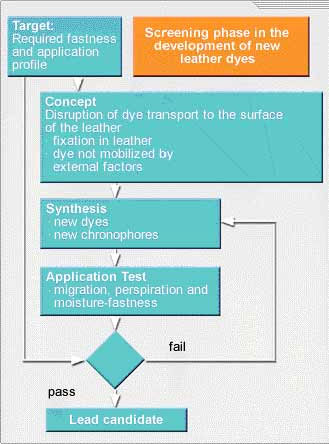Leather dyeing usually involves the use of spirit or alcohol based
dyes where alcohol quickly gets absorbed into moistened leather. Leather
dyeing formulations are similar to lacquers. They consist of a dye or
pigment, a casein or nitrocellulose resin, and a solvent.
The types of dyestuff that are used by tanneries generally varies depending
on the product range needed along with the dictates of the fashion world. It
is a fact that each tannery uses between 50-100 or more different types of
dyestuffs.
The leather industry primarily uses anionic dyestuffs, that can be
divided in the following families:
- Acid dyes
- Mordant dyes
- Direct dyes
- Basic Dyes, its use is also limited.
- Pre-metalled dyes
- Solubilised sulphur dyes
- Reactive dyes although a part of the anionic group of dyes but use
limited to a certain extent.
If we see from the chemical point of view the dyes used are mostly Azo
dyes, Anthraquinone dyes and Triphenylmethane dyes. Commercially speaking,
popular Black dyes account for nearly 60-70% of all leather dyeing. Also,
out of this a dye variety called Acid Black 210 dominates with 80-90% usage
of all of the black dyes used.
Yes! I am Interested
Applying high temperatures releases the
fat-soluble components of conventional leather dyes out of their chemical
bonds. Now these components has a tendency to migrate upwards into the
layers whose task is to give the smooth finish to leather surface. This
causes a visible change of color and intensity. What happens is that with
the rising of humidity, it is quite likely that non-permanent dyes that are
water-soluble, and low in molecular weight, will be washed out. Along with
the problems like spotting and discoloration. Also there is the risk that
migrating dye components can rub off on other materials such as plastics or
textiles.
With latest technology of dyeing leather, the development and production of
high-fastness dyes reached on top level. Now, the manufacturers get high
quality leathers for making leather products.
Here is a flow chart that describes the process criteria of selection of
leather dyes :


![]() Profile
Profile ![]() Product Range
Product Range![]() Industries
Industries![]() Infrastructure
Infrastructure![]() Our Quality
Our Quality![]() Custom Manufacturing
Custom Manufacturing![]() Network
Network![]() Contact Us
Contact Us![]() Send Enquiry
Send Enquiry


![]()

![]() Profile
Profile
![]() Product
Range
Product
Range![]() Industries
Industries![]() Infrastructure
Infrastructure![]() Our
Quality
Our
Quality![]() Custom
Manufacturing
Custom
Manufacturing![]() Network
Network![]() Contact
Us
Contact
Us![]() Send
Enquiry
Send
Enquiry